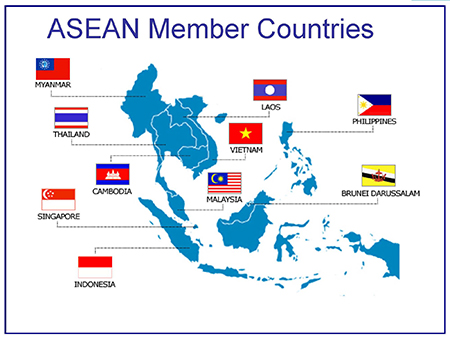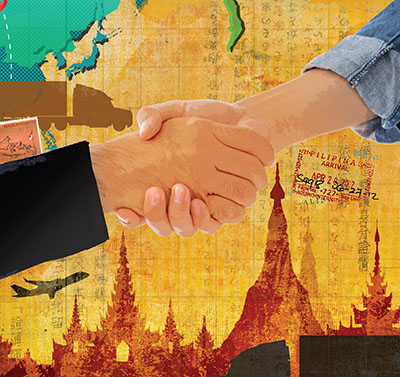ASEAN Logistics: Building Collectively
While most of the world withdraws inward, Southeast Asia is practicing effective cooperation between the state and private sectors to improve its logistics infrastructure and services to attract even more multi-national interest.
“While progress in logistics performance has slowed for the first time since 2007 for many developed countries, ASEAN economies displayed a mixed bag in 2016,” observes Cecile Fruman, global practice director of the trade and competitiveness division at the World Bank.
According to the latest edition of the “Logistics Performance Index (LPI),” part of the biannual report published by the World Bank Group, Singapore, Malaysia, Thailand and Indonesia all outperformed the East Asia and Pacific regional average. Meanwhile, Indonesia, Vietnam and the Philippines ranked among the top 10 in lower middle-income countries.
“However, all ASEAN countries except Singapore, Myanmar and Cambodia back slid in their 2016 rankings compared to two years ago,” says Fruman.
According to estimates by the Asian Development Bank (ADB), ASEAN requires an annual infrastructure investment of $60 billion to 2020, with more than 62% earmarked for the development of the transport and energy sectors. Separate research carried out by Goldman Sachs states that Indonesia, Malaysia, Thailand and the Philippines alone will require more than $550 billion in infrastructure investments during the same period.
ASEAN logistics gap
The World Bank report found that the “logistics gap” between more and less developed countries persists—high-income countries on average score 45% higher on the LPI than low-income countries.
“While low performers appeared to be closing this gap in past surveys, this trend has reversed in 2016, and the distance between top ranked countries and those at the bottom of the list has widened,” says Jordan Schwartz, director of the World Bank Group’s Singapore hub for infrastructure and urban development.
But income alone does not explain performance, adds Schwartz. Countries such as Cambodia and Myanmar improved their performance, which shows that the willingness to reform and implement good practices and policies has a direct impact on the fluidity of cross-border trade.
“Infrastructure continues to play a big role in assuring basic connectivity and access to gateways for most developing countries,” says Schwartz. “In all income groups, survey respondents reported that infrastructure was improving. However, in all ASEAN countries except Singapore and Malaysia, the scores for infrastructure were lower than the overall scores.” 
Better logistics connectivity—not only just within states but between countries in ASEAN—will boost the region’s value chain and economy, maintains Max Ward, CEO and co-founder of Open Port, a neutral mobile platform for “enterprise” supply chain management in emerging markets.
“This is not an easy task,” Ward adds. “There are, in fact, a number of deep seated problems on the horizon for the logistics and supply chain industry that could hinder the future growth of AEC.”
Ward notes that the largest economy in the AEC—Indonesia—spends 26% of its GDP on logistics, one of the highest rates of spending on logistics per capita in the world. In the meantime, there are major commodity price gaps between provinces in Indonesia a well as major logistics inefficiencies that hamper economic development and connectivity. Likewise, Thailand—despite offering easy access to Cambodia, Vietnam and Laos—still spends almost 20% of its GDP on logistics.
Overcoming logistics fragmentation
Limited facilities at ASEAN ports make congestion worse, but the bigger challenge is the total cost of getting products from manufacturers to consumers, and how land transport actually takes up more time than processing in the ports.
Inadequate rural roads cause long transport times, Ward says. Furthermore, roads are often closed, and poorly maintained open roads can only be used by small vehicles with high operating costs.
In the logistics and supply chain sector, transport is the center of performance, maintains Ward. But there are many companies that don’t think about integrated supply chain management.
“For example, many small manufacturers still use containers only for loading and unloading in ports, rather than at the origin and destination of their cargo,” says Ward. “Highly fragmented supply and demand for road transport services means that truckers frequently return home empty, which eats up costs and erodes margins. In Indonesia, for example, trucking accounts for 72% of transport costs, and yet trucks are only full half of the time.”
At a time of great change in the logistics sector, Ward notes that ASEAN governments have indeed started to focus on policy development and have ramped up invest in revamping long-neglected infrastructure.
“But by itself, this will not help the ASEAN countries to improve their game and boost growth and competitiveness,” says Ward. “In Indonesia, Thailand and several other ASEAN states, there is an urgent need to reform the management of human resources and the adoption of new technologies to support more efficient and effective supply chain management.”
Rail and air cargo networks are also inadequate in many ASEAN nations, note transport analysts. Frank Harder, a principal with the consultancy Tioga Group, observes that more on-dock rail will be needed throughout Vietnam and the Philippines.
“With new ocean cargo deployments in all-water service, port will need to invest in rail,” says Harder. “Obviously, the same goes for intermodal.”
Chuck Clowdis, managing director of transportation advisory services for IHS Global Insight, observes that airports—with the exception of Singapore—need major upgrades. “It’s finally a relief to say that air cargo is ramping up in ASEAN,” he says, “but the need for new runways and warehousing is critical.”
Post TPP fallout
When President Trump fulfilled his campaign promise to pull the United States out of the proposed Transpacific Trade Partnership (TPP) last month, many trade analysts expressed stronger support of existing ASEAN relationships.
“There certainly needs to be more bilateral cooperation in the Asia-Pacific without TPP,” says Jonathan Gold, vice president, supply chain and Customs policy for the National Retail Federation. “This is not only true for retailers, but also agricultural shippers and light manufacturers.”
Rosemary Coates, president of Blue Silk Consulting, says that it’s very likely that China will step in to fill the void, while influencing and accelerating its own transport development across Asia. “That makes ASEAN much more critical to our national interests,” she says. “We must also help these nations with their ‘digital’ transport infrastructure.”
Coates recently led a process design workshop in Singapore for all the member ASEAN countries. Their government representatives had been working for several years on the technical software specifications of the ASEAN “Single Windows” project that’s being undertaken to establish technical standards to facilitate importing and exporting between the countries.
“They had just begun to design the standardized physical processes to complement the technology,” recalls Coates, “and I was surprised at how difficult it was to broker an agreement on any standards.”
According to Coates, ASEAN members are still at different stages in development and sophistication of logistical systems. “Singapore, for example, is developed with modern ports and a high level of computerization in trade management,” she says. “ Myanmar is on the other side of the spectrum, and just beginning to develop fundamental infrastructure and computer systems.”
Outside influence and funding from the United States Agency for International Development and other organizations is also important to continue this trade standardization work and stabilize this region, adds Coates. “However, it’s very unlikely now with the United States backing away from new and existing trade agreements.”

Article Topics
Global Trade News & Resources
Key benefits of being an Amazon Business customer with Business Prime Maryland DOT: $1.9 billion and up to four years to rebuild bridge sunk near Baltimore port Baltimore suing ship that crashed into bridge, closing port, costing jobs UPS reports first quarter earnings decline Supply Chain Stability Index sees ‘Tremendous Improvement’ in 2023 Descartes March Global Shipping Report highlights ongoing steady volume momentum U.S.-bound import growth track remains promising, notes Port Tracker report More Global TradeLatest in Logistics
Key benefits of being an Amazon Business customer with Business Prime USPS cites continued progress in fiscal second quarter earnings despite recording another net loss U.S. rail carload and intermodal volumes are mixed, for week ending May 4, reports AAR New Ryder analysis takes a close look at obstacles in converting to electric vehicles Norfolk Southern shareholders sign off on 10 board of directors nominees Between a Rock and a Hard Place Inflation and economic worries are among top supply chain concerns for SMBs More LogisticsAbout the Author
Subscribe to Logistics Management Magazine

Find out what the world's most innovative companies are doing to improve productivity in their plants and distribution centers.
Start your FREE subscription today.
May 2024 Logistics Management

Latest Resources
















